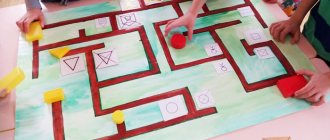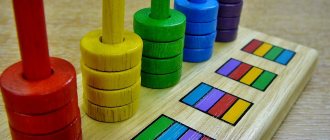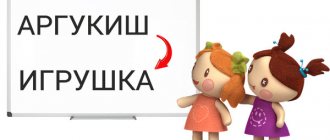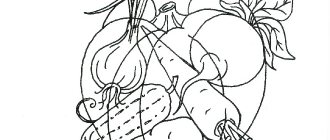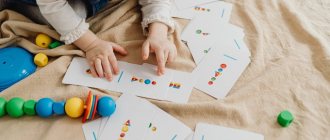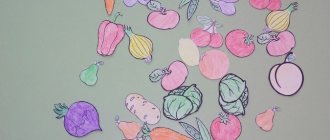Published: 10.20.2020 Category: DevelopmentAuthor: editor
- How to do it yourself?
- The essence of the technique
- Dienesh's Original Theory: Six Steps to Learning Math Concepts for Kids
- Games with kids
- Lesson program with blocks: goals and objectives for different age groups
- History of creation
- Best age
- Games with Dienesha blocks for the older group
- Open lesson using Dienesha blocks in preschool educational institutions
- Examples of activities
How to do it yourself?
Dienesh logic blocks can be purchased in stores, downloaded from the Internet and printed, or you can make them yourself. But someone from the male half of the family should help solve this problem (it’s impossible to do without their hands, tools and skills).
We will not describe in detail the handmade methods of creating Dienesh blocks at home (you can easily find the exact step-by-step algorithm of actions and dimensions of the parts on the Internet). Let's just say that for one of the options for making blocks, you may need the following simple set: a wooden beam (or old wooden cubes), a jigsaw, sandpaper, watercolor paints in blue, yellow and red, a pencil, a ruler and a compass. Finding such things will not be difficult for men. But this process can bring a lot of joy to you and your children. And you can also find information on how to create a special album yourself and master several games on the Internet.
The essence of the technique
Dienesh developed a methodology for teaching mathematics and showed us with numerous examples that this is a rather interesting and entertaining science, and uses many more useful things in its development.
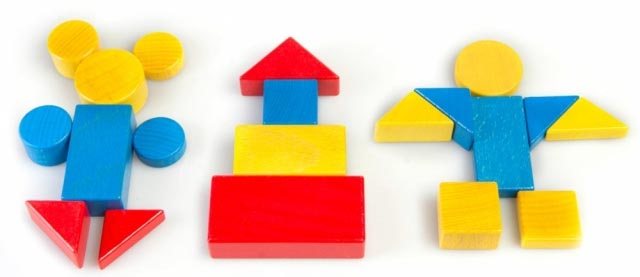
Thanks to many years of practice among preschool children, Dienesh presents us with unique teaching aids. His method has 6 steps.
Along the way of developing mathematical abilities, the creative and intellectual potential of the child is simultaneously affected and revealed, and sometimes the parent, playing with the baby without noticing it, gets carried away by the game.
Each stage carries a certain load and without the previous one you cannot move on to the next.
Here you will not find boring notebooks and boring textbooks; there is a game everywhere, funny drawings, unusual mysterious diagrams and symbols that you just want to solve. So,
Introductory stage. When the child first saw and began to get acquainted with the educational material. The mother gives the child the simplest task and does not try to help the child; he must try to solve the problem himself. As a rule, kids don’t try to think about this and quickly decide how it will work out or how it won’t work out at all. After this, the second stage of training begins. Here the mother should try to explain the new, slightly more complicated tasks in a manner understandable to the child.
It is important that the child understands what is required of him; this is the essence of learning.
The third stage can be called comparison. Here the child learns to compare and is offered approximately identical tasks, but different materials can and should be used to solve them.
At the fourth stage, the tasks become more complicated, but this only makes it more interesting, because this is what the author wanted
He recommends using tables and maps at this stage. Here we get acquainted and analyze the composition of numbers and new mathematical concepts.
The fifth stage is even more interesting. We move on to teaching symbols, both special mathematical symbols and ones we invent ourselves or together with our mother, and it’s even more fun to involve the whole family.
At the sixth stage, the Nobel Prize awaits us and we will learn what a theorem and axiom are. We learn to analyze and draw conclusions from our own conclusions.
The task for parents is to study the technique themselves and to interest the child as actively as possible.
He won’t be interested in playing on his own, but that’s again my opinion. My child himself doesn’t even play from albums. It was not like he sat down and began to lay out something on his own. He is not interested and bored. I always play with him. And I try to captivate him as much as possible and then I see the result, he does better the tasks that he did earlier.
Additional cards
When your child has mastered all the variations of these games, it’s time to move on to the next stage. The Dienesh blocks have prepared a huge number of possibilities for this. The tasks will become more difficult over and over again, preventing you from getting bored. Now you need to buy or print a new album that contains a set of cards. The signs of the figure are encrypted on them in symbolic form.
- The color is indicated by a spot in the form of a cloud.
- Size is the silhouette of the house; it can be large or small.
- Shape – black outline of a figure (circle, square, triangle).
- Thickness – a funny person, fat or thin (thin).
Children love such puzzles very much. But there's a catch. Remember about finding figures by contradiction? This is also preserved in ciphers. That is, the card may contain two spots, red and yellow, each of which is crossed out by a line. This means that the desired object is not red or yellow, but blue. If, in addition, there is an outline of a square on the card, then the solution has been found. We need a blue square.
Dienesh's Original Theory: Six Steps to Learning Math Concepts for Kids
Zoltan Dienes is a famous Hungarian mathematician, practicing teacher and psychologist, who radically changed the stereotypical perception of mathematics as a routine and uncreative scientific discipline. Z. Dienesh's gaming methodology is aimed at helping children of preschool and primary school age to master a variety of mathematical concepts in an entertaining way, to form and develop the most important intellectual skills and psychological processes necessary for independent logical thinking.
Personal teaching experience and knowledge in the field of developmental child psychology helped Z. Dienesh to invent and implement the concept of six steps of learning mathematics for the little ones. In addition, the theory received original methodological equipment with a complex of didactic materials in the form of additional game aids and visual logical blocks, which became an effective tool for the development of the creative and mental potential of children. The methodology is used both in official pedagogy and in the self-education system.
The use of Dienesh's logical blocks in the development of logical and mathematical thinking in preschool children
The idea of six steps for mastering mathematical knowledge and skills has undergone successful practical testing and proven its effectiveness. The substantive features of each stage received their own name:
Free creative play. The content of this phase consists of the teacher setting a specific task for the child. In search of a solution, the child goes through spontaneous options and experimentally finds the correct answer. This is the stage of introducing the child to the task that needs to be resolved. This is how a child begins to learn mathematical wisdom. Rules of the game. Having overcome the stage of trial and error, the baby begins the second phase - learning the rules of the game
It is important for a teacher or parent to correctly and clearly convey to the child’s mind the most important information about the rules for achieving the desired result. Matching phase. Taking the third step, the child faces the need to perform the mental operation of comparison
The author of the method invites adults to test the idea of several games with similar meanings, but with different didactic material, in games with children. For example, first we play with blocks, then we cut out animal figures or lay out geometric shapes. We must see that the child independently solves the algorithm for correctly achieving the goal, regardless of the game material. In this way, you can make sure that the baby’s intellectual actions are meaningful and are not the result of mechanical memorization and automatic reproduction. This stage is necessary for the development of abstract thinking abilities. Introducing the abstract number symbol. At the fourth stage, various diagrams, maps and game tables will be in demand for the development of visual perception, the formation of visualization skills, and familiarization with the abstract meaning of numbers. Symbolic stage. The fifth step leads the child to the conclusion that the logical chains of various game series lead to a common result. To understand game cards, a special language of symbols is needed, which the child himself creates during the lessons. Stage of independent conclusions. The final stage will be the longest. The child, with the help of an adult, studies the meaning of the terms axiom and theorem, and independently draws the necessary logical conclusions based on the description of the rules of playing cards.
The possibilities of the manual are not limited to classes on the formation of basic mathematical knowledge; you can play Dienish games while learning English. Preschoolers post images, selecting the desired shapes and commenting on their actions (“big blue triangle”, “little yellow square”)
Dienisch developed his methodology for children in the age range from two to eight years, taking into account intellectual and psychological characteristics, so mathematical lessons are perceived with enthusiasm and passion. Adults need to be patient in studying the theoretical part of the method, as well as understand the set of teaching aids
The child’s developed ability to quickly and freely cope with complex mental exercises will be a worthy reward for parents and educators for their diligence and perseverance.
How does mathematics learn?
Zoltan Dienes studied the characteristics of children's cognitive processes and noted an interesting detail. Almost everyone understands the basics of mathematics, but as soon as it comes to more complex operations where logical thinking is required, most schoolchildren cease to understand the essence. They try to follow a pattern, but the solution is different every time. Then the scientist concluded that this is the first stage of studying mathematics: a chaotic search for a solution and inevitable mistakes. This is the free play stage, but each of these games must contain rules. Studying them is an important task.
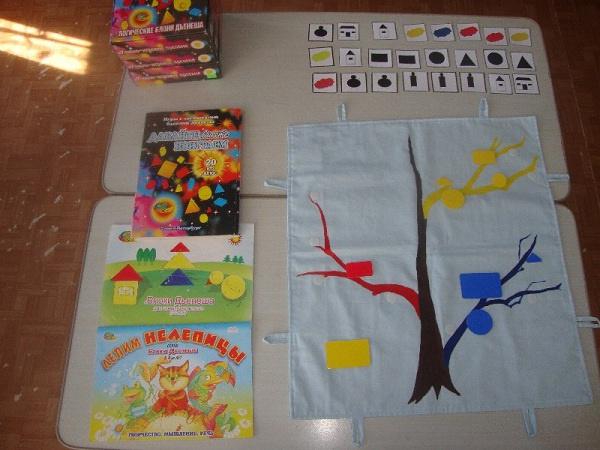
Only after this do children come to the conclusion that certain actions lead to the same results. And only then comes the realization that the conclusions drawn in the process can be theorems. A secondary school program and beyond can easily be built on such a base.
Games with kids
Dienesha blocks can be used from the age of 2 years, but the average age when children begin to develop an interest in them is 3 years.
The following exciting and useful games can be included in the schedule of the little ones.
- Distribution of figures into groups. The simplest task is to arrange the elements of the set into piles depending on color. Then the task becomes more complicated, the parent asks the child to group elements of the same size and shape. Next - even more interesting: now you need to find, for example, a yellow triangle among the elements.
- “Find the same one.” The parent shows the child a certain figure, for example a blue triangle, and asks him to find a similar element from the set, for example a triangle of any other color or some yellow element. The “Find another” task is performed in a similar way, but now the child’s task is to find a different figure (of a different color, shape, size).
- Games with albums. To do this, you need to purchase or download special colorful pictures on the Internet that depict flowers, animals, cars made from geometric shapes. The child will need to understand which element of the set should be attached to the picture (for example, a circle is a car wheel or a flower petal), decide on the color and size and complete the drawing.
- "Let's feed the animals." A great game for kids that will teach them how to sort figures into groups. The parent creates a kind of zoo by seating toy animals at the table. Next he gives the task - to feed them, using elements from the set as food. But each of the inhabitants of the menagerie eats only his own food (for example, the lion cub likes red figurines). The child’s task is to feed the animals. The tasks should be gradually made more difficult. After some time, the lion cub should fall in love not just with red elements, but with squares.
- Construction. This is a very interesting game for children 3-3.5 years old, allowing them to develop their creativity. Parents ask the child to create a house, a piece of furniture, a ladder - the child constructs the proposed options.
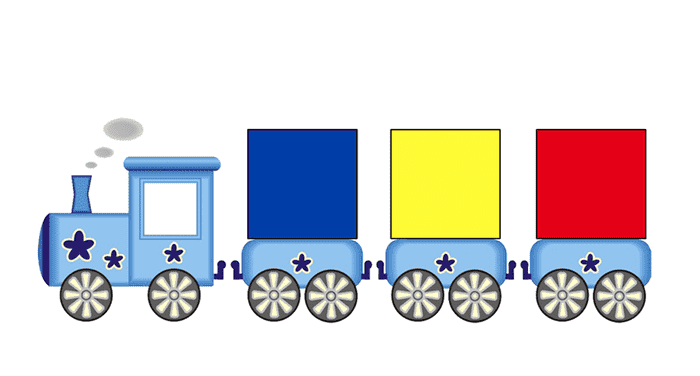
- Lay out a simple “chain” of red, yellow and blue elements on the table and invite the child to continue the row. His task is to distribute the colors in the correct sequence.
- Invite the child to continue the chain in such a way that there are no identical figures nearby (for example, the circles are not located one after the other, the red elements are not next to each other).
- Come up with a row yourself so that next to each other there are figures of the same size, but different in color or shape.
Such tasks will help you learn to identify the properties of figures and carry out analysis.
Junior group
For children of a younger age group, primitive games are suitable, in which you need to group and separate objects according to parameters.
Find the same one
The teacher shows the figure. The player must find the same object based on one parameter: geometry or color. For example: a yellow triangle is shown. This means you need to find either red and blue triangles, or other yellow shapes.
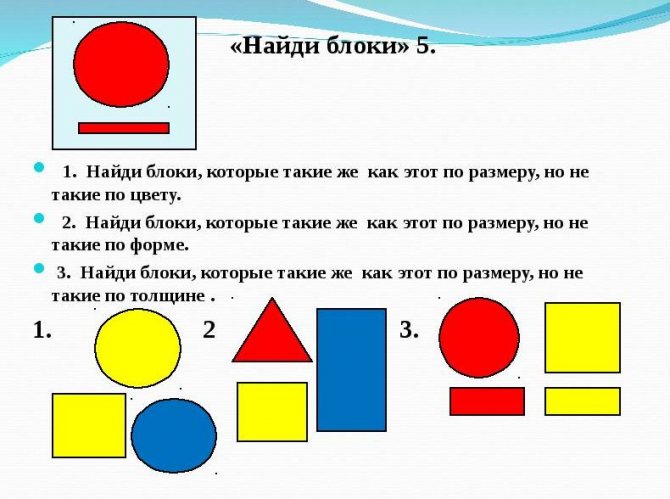
Find something different
The opposite of the previous task. It is required to find figures that differ from the demonstrated element in a certain parameter: size, color, geometry.
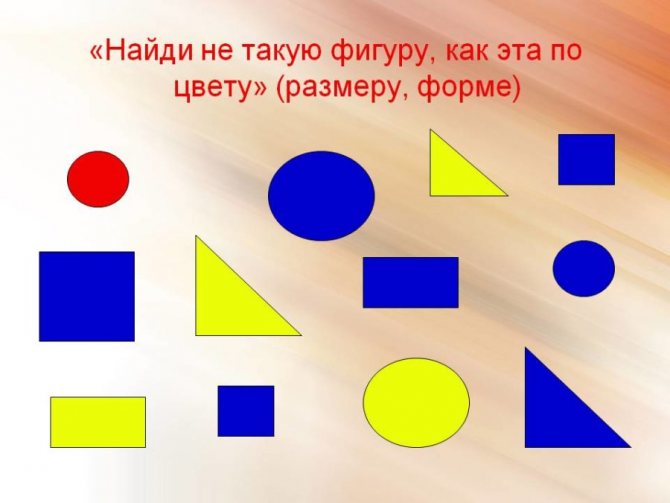
Plant in the beds
For the game you need to prepare improvised beds. The blocks will be vegetable seeds. The teacher gives the task to plant the seeds in certain beds. For example, for the first bed - small and red, for the second - square and yellow.
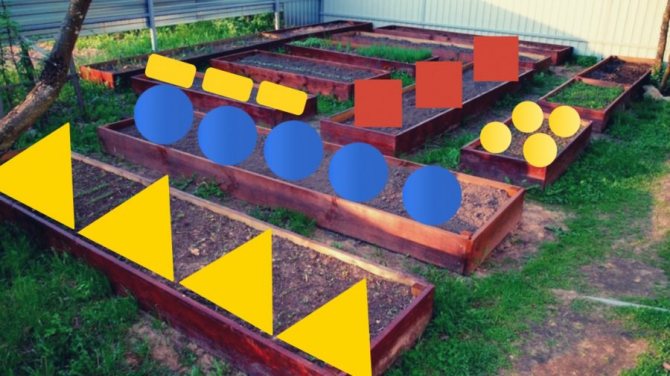
Feed the toys
To play, you need to place dolls or soft toys on the table. Dienesh blocks will be food. The teacher explains that toys want to eat, but each of them has its own food. For example, a teddy bear eats large yellow figures, and the Masha doll eats small blue ones. The players’ task is to choose the right blocks for each toy.
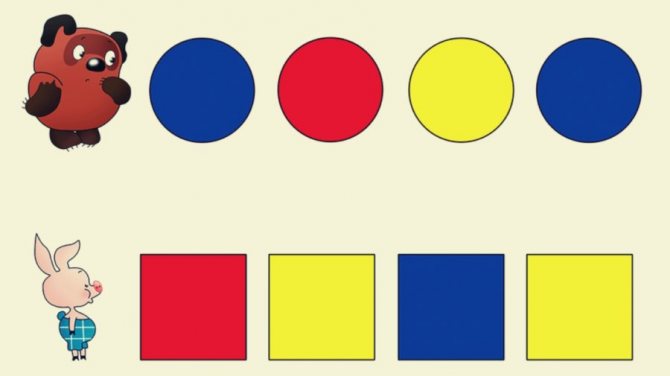
Lesson program with blocks: goals and objectives for different age groups
The goals of Z. Djeniš's method of early development of mathematical abilities:
Acquaintance with the basic geometric shapes, as well as the concept of a standard form, the formation of the ability to determine the color and size of an object, the development of the concept of set; Acquiring primary skills in algorithmic thinking; Activation of memory, development of the ability to concentrate and maintain attention, as well as mental processes of imagination and speech; Formation of spatial thinking, modeling and design skills; Actualization of creative potential; Development of an intellectual culture of thinking: the ability to compare, generalize, systematize, carry out independent analysis, understand the meaning of an abstract sign, encode and decipher information, give reasons for your statements. Nurturing personal initiative and strong-willed qualities in achieving educational goals, solving practical problems and overcoming obstacles.
Construction will develop imaginative thinking and creative abilities of the child, activates fantasy and imagination.
Features and general rules for using visual aids for each age category:
The ability to determine one property (shape, color, size or thickness).
The first junior group (2–3 years old) – Z. Dienesh’s blocks are in demand starting from the middle of the school year as an additional element in play activities. The teacher gradually includes blocks, additional diagrams and cards in order to form and consolidate an idea of one property of an object. The acquired skill of operating with a single property of an object is applied not only to the game manual, but also to fairy-tale literary characters, thus expanding the space of game modeling and activating the fantasy and imagination of children. For greater comfort and efficiency of classes, it is recommended to distribute children into small subgroups.
Video: Logical blocks of Dienesh in the first junior group
https://youtube.com/watch?v=yhQVkuDZzFcVideo can't be loaded because JavaScript is disabled: Dienesh logic blocks in I ml group (https://youtube.com/watch?v=yhQVkuDZzFc)
Feature matching skills.
- The second younger group (3–4 years old) - the teacher includes the concept of a second qualitative distinctive property; by the end of the school year, children freely distinguish between two properties of an object and its symbolic encrypted image in the form of a card. The ability to read cards containing coded information about the properties of an object develops, and the acquired skills are used in a logic game.
- Middle group (4–5 years old) – over the course of a year, children master the skill of identifying and comparing three characteristics. Gradually, the negative particle “not” is introduced into the speech lexicon. Situations are actively played out when each child is given three symbol cards and asked to select the corresponding logical blocks or figures, which then must be used as building bricks according to a given algorithm of actions, for example, for the joint construction of a building or the construction of a road, playground, etc. .
Improving acquired skills in conditions of increasing complexity of tasks on logical operations of systematization and classification.
Senior and preparatory group (5–7 years old) - the practice of using cards for three properties continues, by the end of the school year the fourth property is introduced. The teacher’s task is to teach children to strictly follow the rules of the game, to consolidate in the child’s mind the understanding that violating the correct sequence will not allow achieving the desired result. The range of gaming exercises becomes more diverse and complex thanks to the use of new didactic tools such as hoops and algorithmic schemes.
Logic cubes, like symbol cards, will help you come up with a variety of games with your children, and these games, in turn, will be useful for mastering the actions of substitution and visual modeling, encoding and decoding
In carrying out the final diagnostics of the success of teaching activities according to the method of Z. Dienesh, one should focus on the following predicted result:
- Pupils improve their communication skills and their desire to cooperate in educational and gaming activities increases.
- Logical thinking develops, the cognitive and creative potential of children is revealed.
- Children show more independence and activity.
- The initial stage of mastering mathematical knowledge is successfully overcome, and interest in this academic discipline is established.
History of creation
It is interesting to look at some facts from the biography of the Hungarian teacher, mathematician and child psychology researcher Zoltán Dienes. It was he who gave children of all countries a wonderful way to develop and comprehend the mathematical side of reality. He really wanted to create something that would make mastering exact mathematical science comfortable, interesting and entertaining. As a result, he achieved his goal and developed an excellent technique, which is very popular among teachers and parents.
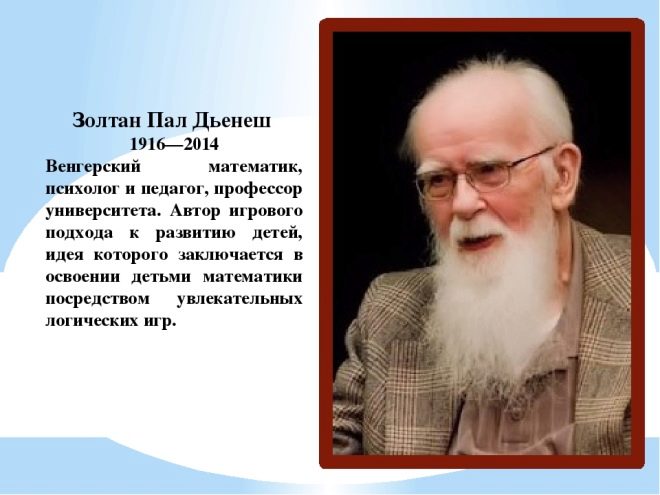
The learning process should not be boring, Zoltan Dienes believed
When something is explained to a child for a long time, he needs to listen carefully, then try to repeat what he heard, then he, as a rule, loses interest and cannot maintain stable attention for a long time
While examining the peculiarities of the development of mental abilities in preschool children, Dienesh made an important conclusion: children cope well with mastering numbers and simple arithmetic, but they are extremely weak in understanding abstractions. The child searches for an answer, often using a pattern (scheme) already known to him.
But the search is not always successful. Based on this fact, Dienes came up with a way to familiarize yourself with complex abstract categories in an accessible visual form. This approach is an important component of preparing a child for further education at school. But on top of everything else, it brings kids a lot of fun in the process of mastering logic.
Field for imagination
In order not to get bored - after all, any thing gets a little boring - you can add absolutely any scenarios.
For example, build baskets and put wooden fruits in them - that's what you have, or real fruits, and then have fun crunching them. You can take various interesting animals and build different ships for them. And these animals will travel with us. Don't be afraid to create, don't be afraid to experiment.
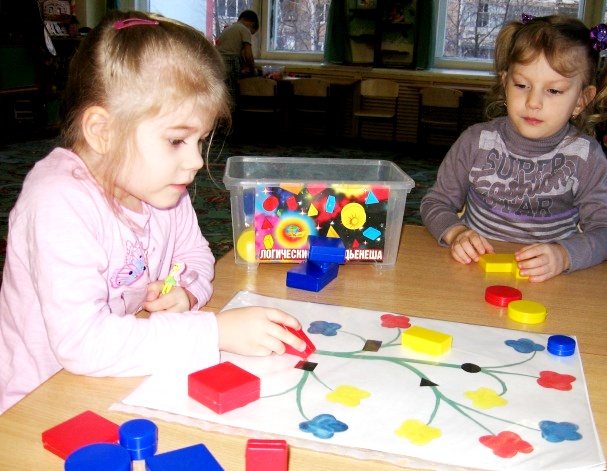
If your cubes are not wooden, then you should try to compensate for this with different materials. The materials are all different in texture: very noisy, ringing plastic; and a wonderful tree; and everyone’s favorite glass – heavy, smooth, noisy; and wonderful bright multi-colored buttons.
This is the universality of the aids - the principle that you can use whatever is at hand to play. Moreover, if you do not have the opportunity to buy a manual, you can open a page on the Internet and see the entire list of materials.
You can, if you don’t have wood, glue them together from cardboard and create this educational set for your child, so universal that you can go with it into a long life as a researcher of physical phenomena and a young conqueror of interesting mathematical tasks.
Best age
Children of different age groups can practice with Dienesh blocks.
- The youngest children - from 2 years old - can use the elements of the set as substitute objects and play simple, exciting games (for example, “Feed the Animals”).
- Secondary preschool group. With the help of colored figures, children can build various pictures, using ready-made diagrams or using their own imagination.
- Senior preschool group. Blocks are a great way to improve math skills, learn to count, and gain the most important concepts of “more” and “less.”
- Elementary School. Numerous classes with Dienesh blocks will allow you to work through issues that you couldn’t figure out in class in a fun, non-boring way, as well as consolidate your knowledge and improve your ability to think logically.
Each age has its own exercises that will be interesting and accessible to children. Parents can use ready-made options from the file cabinet or come up with something of their own.
Logic cubes
This is a separate material that is sold along with the set, but you can make it yourself by downloading the diagram, cutting out and assembling the cube along the dotted lines. This is an ordinary cube, on the sides of which there are signs of objects, just as you see on the cards described above. There are 5 cubes in total, each of which is dedicated to such characteristics as size, shape, thickness, color, and symbols of negation of properties. There is also a digital cube.
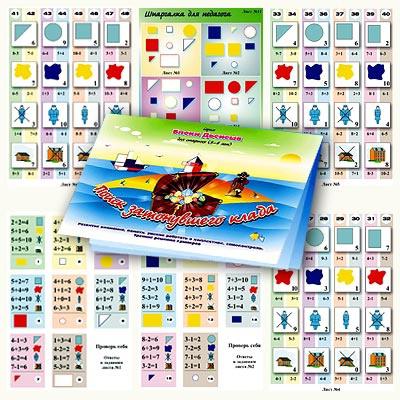
This is a game element; it introduces a share of random choice into the activity, when you roll the dice, and for you it chooses the characteristics of the object with which you will then have to interact. Children love this very much.
Games with Dienesha blocks for the older group
When the child grows up, he will be able to click the exercises for kids like seeds, and the tasks will have to be complicated. Dienesh's method for preschoolers is designed for children 5-6 years old. The exercises are more complex; not only the cubes themselves are actively used, but also cards and game albums. The tasks are aimed at developing logical thinking in an adult child and the ability to explain the decision made. Study a few games as examples, based on which you can come up with many more exercises.
Search
Give your child any figurine of Dienesh or offer to choose one yourself. Then, from the total mass of blocks, he will take out all those that coincide with the first one in one given property. Once he has mastered the game well, make it more difficult. Let the child select blocks that have two identical properties to the one originally taken. Then you can make the game even more difficult. The child must choose those blocks that do not have a single adjacent property with the first one.
Domino
This game is suitable even for several children. Rules:
- Each player receives an equal number of blocks. The order of participants is determined.
- The first one makes a move with any piece.
- The second one places a block that has one of the same properties.
- If there is no suitable piece, the participant misses a move.
- The first one to lay out all his blocks wins.
- The game can be complicated by changing the rules about the properties of the pieces being laid out. For example, you need to respond with a block that has two similar characteristics, etc.
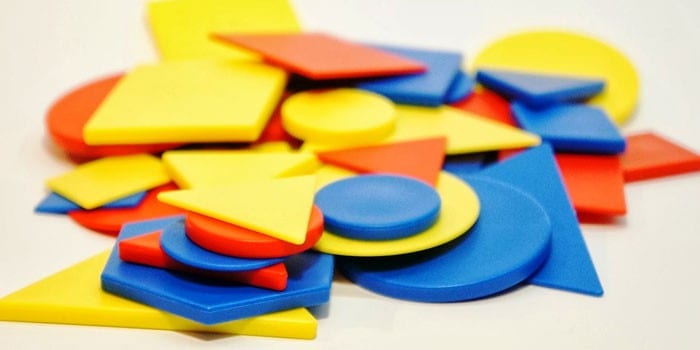
Find the odd one out
The following game will help children learn to group three-dimensional geometric shapes according to various criteria. Rules:
- Place three figures in front of the child. One of them should not have a single property in common with the others.
- Let the child figure out which block is extra and explain why and how he came to this conclusion.
- Make the task more difficult. Lay out 6 blocks. The baby must remove the extra two.
Find a match
This game will appeal to children who have already mastered all the simple tasks well. Rules:
- Place several figures in a row in front of your child.
- Offer to select a steam room for each according to a specific property.
- Make the task more difficult. Let the child try to choose a pair based not on one, but on two or three properties.
- You can initially take, for example, 10 paired elements. Place them in a bag. Let the child make the pairs himself, laying out the Dienesh figures in two horizontal rows.
Artists
To play the game you will need several large sheets of colored cardboard. They serve as sketches of paintings. To compose the composition, additional cardboard parts are needed. The game teaches you to analyze the shape of objects, compare them, and develops creative and artistic abilities. Rules:
- Based on the sketches, the kids must “paint” a picture.
- They choose the preparation themselves. It shows schematically where which blocks should be located. Thin ones will only be outlined, and thick ones will be completely painted over.
- Let the children select the missing blocks and parts cut out of cardboard to the correct places in the “sketch”.
Shop
For this task you need cards with images of objects that will serve as goods, and logical elements. The game “Shop” develops memory, the ability to reason, justify your choice, identify and abstract properties. Rules:
- A preschooler comes to a store that has a variety of card products. He has three figures that perform the function of money. You can purchase one item for each.
- The child needs to buy an object that has at least one property that matches the money figure.
- You can gradually complicate the game by offering new rules.
Let's decorate the Christmas tree
The following game helps develop the skills of ordinal counting and diagram reading. For it you will need an image of a Christmas tree and 15 cards with symbols and blocks. Rules:
- The Christmas tree should be decorated with beads in five rows. Each will contain three beads.
- The number on the card is the serial number of the position of the thread from top to bottom. The circle painted on it shows which number the bead should go, and below it indicates which element will represent it.
- Let the child hang the first row of beads, and then all the lower ones, strictly following the diagram on the card.
Open lesson using Dienesha blocks in preschool educational institutions
Tasks using Dienesh's logic blocks can be demonstrated in an open lesson, since the use of various developmental aids in the preschool pedagogical process is very relevant today. Colleagues will be interested in seeing games and exercises with mathematical content, especially if they were invented by the teacher himself.
You can organize such an open viewing with children of different ages, starting from the second youngest group: kids will be interested in manipulating with multi-colored figures. To make the event successful, the teacher can additionally use ICT tools and involve game characters. Integrated classes are interesting, where one type of educational activity smoothly flows into another. As for specific topics for open viewing, you can build a lesson in the form of a journey (“Journey to the City of Geometric Shapes”, “Holiday in the Land of Magic Blocks”, etc.), or immersion in a fairy tale (for example, “Let's Help Doctor Aibolit” , “On a visit to Prostokvashino”, etc.).
After an open lesson, there is a mandatory discussion by teachers. Justifying the effectiveness of his methods and techniques, the teacher can invite his colleagues to perform certain exercises themselves based on Dienesh’s developmental manual.
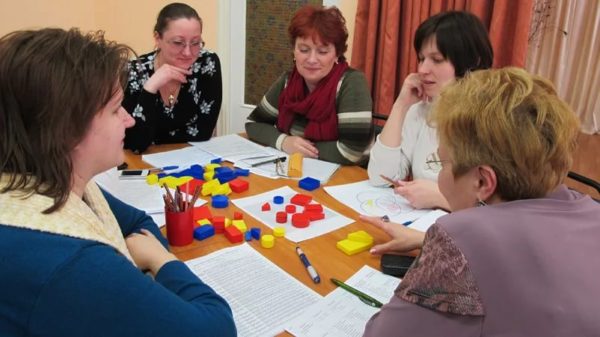
Discussion of open viewing may also include a practical part - exercises for adults with blocks
Table: example of a summary of an open lesson on FEMP in the second junior group (fragment)
| Author | Tsaparina I.V., teacher, GBOU School No. 1155, preschool department No. 2, Moscow. |
| Subject | Journey to the winter forest |
| Target | Expand and enrich basic mathematical knowledge through research activities. |
| Progress of the lesson | The teacher invites the kids to go for a walk in the winter forest. Poem reading: A game character appears - the Katya doll. She also wants to go for a walk with the kids. You can get into the forest through the river. The children are offered 2 bridges - a narrow one and a wide one. Children determine that it is more convenient to walk on a wide path. <…>There is a bunny with snowballs in a snowdrift. Game exercise “How many”: using snowballs as an example, preschoolers reinforce the concepts of “one”, “many”, “none”. Katya makes a riddle about a circle that looks like a snowball. <…>The next character is a bear with a red cube. A similar conversation and riddle about the square. A squirrel sits under the tree. Comparison of the height of two Christmas trees. It turns out that the Christmas tree looks like a triangle. <…>To keep the kids warm in the winter forest, the teacher conducts a physical education session: We'll warm ourselves up a little, we'll clap our hands, we'll stomp our feet, and we'll clap ourselves. Katya is driving a truck, she says that a snowman came with her. He is bored alone and wants to find friends. In the back of the truck is a bag of Dienesh blocks. Using the diagram, kids make up an image of a snowman (individual work). Analysis of composed figures. <…>Katya tore her jacket, caught on the Christmas tree, and asks the children to help put a patch on it. Game exercise with Dienesh blocks “Put a patch”: each child has a diagram on the table indicating what the patch should be (shape, size and color). Katya thanks the children for their help and says goodbye. The teacher praises the children. |
| Quote from: https://www.maam.ru/detskijsad/konspekt-otkrytogo-zanjatija-po-fyemp-v-mladshei-grupe-s-blokami-denesha.html |
Examples of activities
Here are some examples of games and exercises using the Dienesh method. They are used both at home and in junior, middle and senior groups of kindergartens.
"Second row". This game effectively trains the analytical type of comprehension. Multiple shapes must be used. We add them in a certain sequence, for example, triangles of two colors. Let the child try to guess which figure should follow next. If the solution is correct, he must build a triangle of the third color into the row. With another option, you can create a different sequence, for example a series of single-colored shapes. Let the little explorer guess that figures of the same color should be placed next to each other.
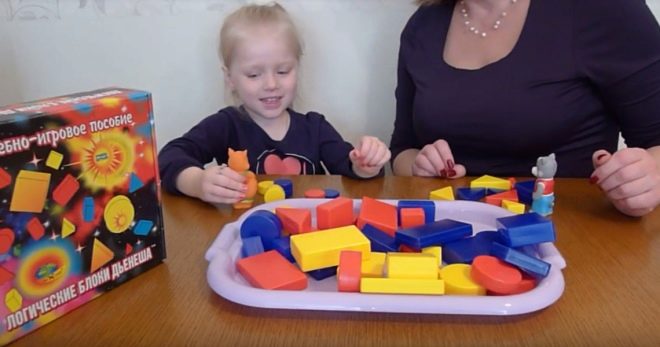
With kids
You can safely introduce children as young as two years old to mastering the Dienesh technique. By the age of three, their interest will increase even more.
A very useful activity for little children will be to simply distribute the figures into different groups, for example by color. It will be more difficult for them to group by size of elements and even more difficult by shape.
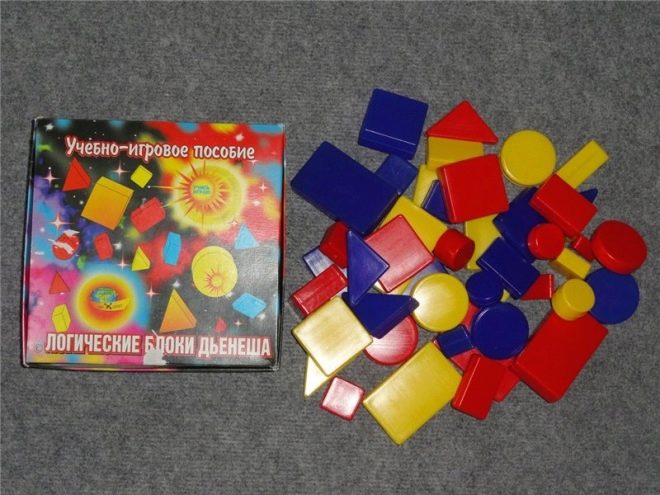
With preschoolers
Four- and five-year-old children enjoy working with Dienesh blocks. They are excellent assistants in preparing for further compulsory lessons at the age of six and seven and for teaching in the first grades. During this period, children can master many interesting tasks in this area.
"Let's decorate the Christmas tree"
One of these is called “Let’s decorate the Christmas tree.” You need to cut out a Christmas tree from cardboard or draw and decorate it. Next, you need to prepare cards with hints on which you need to depict figures painted in the three colors of Dienesh. Next to the image write a number that will indicate the number of figures placed on the Christmas tree. Let the subject try to understand the meaning of these patterns. And then, looking at them and using the elements of the Dienesh block, he will decorate the Christmas tree.
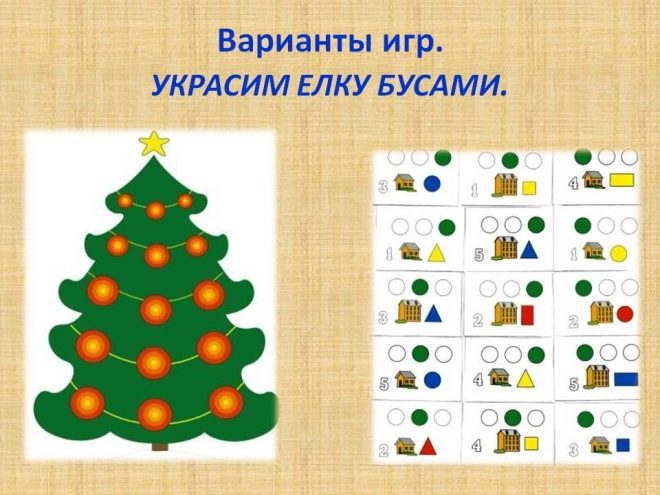
Classes with areas
It is important to introduce the concept of sets into children's thinking. Place red parts inside the drawn circles that do not intersect each other, and yellow parts inside the other circle.
Leave the blue parts outside the circles. In this way, the child becomes familiar with the fact that objects can be inside and outside. When the preschooler understands the essence of this activity, you can begin to complicate it.
Draw intersecting circles, put red figures in one of them, blue ones in the other, and let the student try to guess for himself which parts should be placed at the intersection. These are red and blue parts of the same size and shape, for example squares.
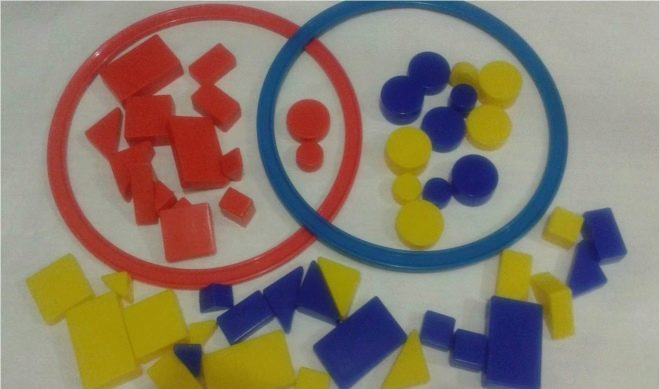
Complicated chain
This is an exercise option for older children. They are asked to create a chain so that neighboring figures have a similar feature. For example, the first figure is a blue square, the second is a circle, but of a different color, the third is a triangle of a color different from the square and circle. When the child can do this exercise without difficulty, you can invite him to come up with similar chains on his own.
Then you need to complicate the task much more: determine the number of objects that will be in the chain, for example eight, put the first and last figures, ask to distribute the elements so that a formed series of figures comes out that do not coincide with each other in any way. But first you need to check whether the problem you came up with has a solution; to do this, first assemble the sequence yourself.
See educational games for preschoolers with Dienesh blocks below.
How to play with LBD?
There is a small manual in the box with the blocks, which is very schematic. You can get acquainted with logical blocks in detail using the books: “Let's Play” (edited by A.A. Stolyar. - M., 1991, 1996), as well as “Logic and Mathematics for Preschoolers” (edited by Z.A. Mikhailova - St. Petersburg, 1996, 2000).
I will share my own experience of working with children as a methodologist - practice manager and home teacher.
All games and game exercises can be divided into 4 groups with gradual complication:
- to develop the skills to identify and abstract properties;
- to develop the ability to compare objects according to their properties;
- for the development of classification and generalization actions;
- to develop the ability to perform logical actions and operations.
All games and exercises, with the exception of the fourth group (logical), are not addressed to a specific age. After all, children of the same calendar age can have different psychological ages. Some of them reach the next stage in intellectual development a little, and some much earlier than other peers, but everyone must go through all these steps. If the child cannot cope with the task on his own, then it is necessary to simplify the task, and so on until the child solves the problem. An independent and successful decision will be the step from which you should start moving forward.
If you keep children at a certain level or give them more complex games and exercises prematurely, then interest in activities will disappear. Children are drawn to mental tasks when they are difficult for them, but doable.
It is good for an adult to become an equal partner during games. He didn’t edify, he played! Before starting games and exercises, let the child independently use them at his own discretion in games. As a rule, children are happy to build something out of them. During such games with blocks, the baby will establish that they have different shapes, colors, sizes and thicknesses. When communicating with a child, it is better to use the word “figure” than the word “block”.
